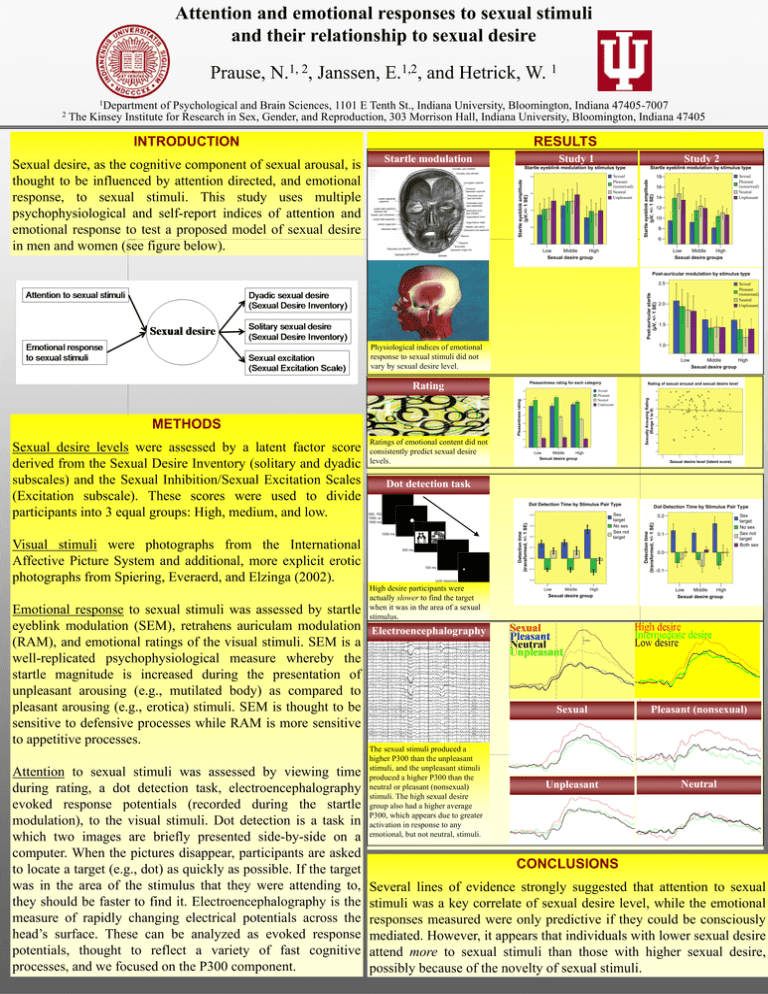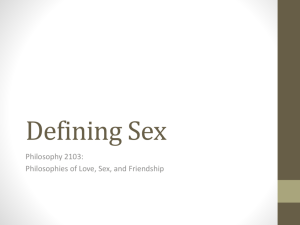
Attention and emotional responses to sexual stimuli
and their relationship to sexual desire
Prause,
1,
2
N. ,
1,2
E. ,
Janssen,
and Hetrick, W.
1
1Department
of Psychological and Brain Sciences, 1101 E Tenth St., Indiana University, Bloomington, Indiana 47405-7007
2 The Kinsey Institute for Research in Sex, Gender, and Reproduction, 303 Morrison Hall, Indiana University, Bloomington, Indiana 47405
INTRODUCTION
RESULTS
Sexual desire, as the cognitive component of sexual arousal, is
thought to be influenced by attention directed, and emotional
response, to sexual stimuli. This study uses multiple
psychophysiological and self-report indices of attention and
emotional response to test a proposed model of sexual desire
in men and women (see figure below).
Study 1
Study 2
Startle eyeblink modulation by stimulus type
Sexual
Pleasant
(nonsexual)
Neutral
Unpleasant
Startle eyeblink amplitude
(µV,+/- 1 SE)
9
8
7
6
Startle eyeblink modulation by stimulus type
Sexual
Pleasant
(nonsexual)
Neutral
Unpleasant
18
Startle eyeblink amplitude
(µV, +/- 1 SE)
Startle modulation
16
14
12
10
8
6
5
Low
Middle
High
Sexual desire group
Low
Middle
High
Sexual desire groups
Post-auricular modulation by stimulus type
Post-auricular startle
(µV, +/- 1 SE)
2.5
Pleasantness rating for each category
Emotional response to sexual stimuli was assessed by startle
eyeblink modulation (SEM), retrahens auriculam modulation
(RAM), and emotional ratings of the visual stimuli. SEM is a
well-replicated psychophysiological measure whereby the
startle magnitude is increased during the presentation of
unpleasant arousing (e.g., mutilated body) as compared to
pleasant arousing (e.g., erotica) stimuli. SEM is thought to be
sensitive to defensive processes while RAM is more sensitive
to appetitive processes.
Attention to sexual stimuli was assessed by viewing time
during rating, a dot detection task, electroencephalography
evoked response potentials (recorded during the startle
modulation), to the visual stimuli. Dot detection is a task in
which two images are briefly presented side-by-side on a
computer. When the pictures disappear, participants are asked
to locate a target (e.g., dot) as quickly as possible. If the target
was in the area of the stimulus that they were attending to,
they should be faster to find it. Electroencephalography is the
measure of rapidly changing electrical potentials across the
head’s surface. These can be analyzed as evoked response
potentials, thought to reflect a variety of fast cognitive
processes, and we focused on the P300 component.
5
4
3
2
Sexually Arousing Rating
(Range 1 to 9)
Pleasantness rating
6
9
8
7
6
5
4
3
1
2
Low
Middle
High
Sexual desire group
-2
-1
0
1
2
Sexual desire level (latent score)
Dot detection task
500, 750,
1000, or
1500 ms
Sex
target
No sex
Sex not
target
0.4
500 ms
100 ms
Until response
High desire participants were
actually slower to find the target
when it was in the area of a sexual
stimulus.
0.3
0.2
0.1
0.0
-0.1
Dot Detection Time by Stimulus Pair Type
Sex
target
No sex
Sex not
target
Both sex
0.2
Detection time
(transformed, +/- 1 SE)
Dot Detection Time by Stimulus Pair Type
1000 ms
Visual stimuli were photographs from the International
Affective Picture System and additional, more explicit erotic
photographs from Spiering, Everaerd, and Elzinga (2002).
7
Middle
High
Sexual desire group
Rating of sexual arousal and sexual desire level
Sexual
Pleasant
Neutral
Unpleasant
8
Detection time
(transformed, +/- 1 SE)
Sexual desire levels were assessed by a latent factor score
derived from the Sexual Desire Inventory (solitary and dyadic
subscales) and the Sexual Inhibition/Sexual Excitation Scales
(Excitation subscale). These scores were used to divide
participants into 3 equal groups: High, medium, and low.
1.5
Low
Rating
Ratings of emotional content did not
consistently predict sexual desire
levels.
2.0
1.0
Physiological indices of emotional
response to sexual stimuli did not
vary by sexual desire level.
METHODS
Sexual
Pleasant
(nonsexual)
Neutral
Unpleasant
0.1
0.0
-0.1
-0.2
Low
Middle
High
Sexual desire group
Low
Middle
High
Sexual desire group
Electroencephalography
The sexual stimuli produced a
higher P300 than the unpleasant
stimuli, and the unpleasant stimuli
produced a higher P300 than the
neutral or pleasant (nonsexual)
stimuli. The high sexual desire
group also had a higher average
P300, which appears due to greater
activation in response to any
emotional, but not neutral, stimuli.
Sexual
Pleasant (nonsexual)
Unpleasant
Neutral
CONCLUSIONS
Several lines of evidence strongly suggested that attention to sexual
stimuli was a key correlate of sexual desire level, while the emotional
responses measured were only predictive if they could be consciously
mediated. However, it appears that individuals with lower sexual desire
attend more to sexual stimuli than those with higher sexual desire,
possibly because of the novelty of sexual stimuli.





